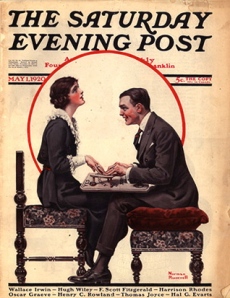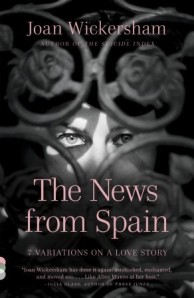There are no faster or firmer friendships than those formed between people who love the same books.
Irving Stone
Like many book clubs, mine celebrates the holidays with a book exchange. This event always draws record attendance — last night, a dozen of us showed up with beautifully wrapped books in hand, ready to steal from one another. We’ve done this so many times we don’t need any instructions, but we received a friendly reminder from our book club “secretary”:
Bring a wrapped book for our annual book exchange (aka STEALING Game) . . . I love the food , drink and camaraderie, but LIVE for the stealing event!
We added a new twist to our traditional “Yankee swap” rules this year: the hostess is allowed to steal any book she wants at the end of the game. We thought that was the least we could do for our hardworking hostess.
I drew a bad number (#3) but still hit the jackpot — I went home with three terrific books, because one generous member of our group bundled three short story collections together. Actually, there were no dud books to be had last night. Everyone left with a great book (or two, or three), excited to begin reading — or coloring.
The Secret Garden and Enchanted Forest (Johanna Bamford) with a set of colored pencils — Adult coloring books have become hugely popular, and devotees say they induce a Zenlike state of relaxation. So when the rest of us are running around doing last-minute holiday errands, one of our group will be calmly coloring the beautiful designs in these books.
 Almost Famous Women autographed copy (Megan Mayhew Bergman) — This collection of “off-the-radar” female historical characters is going to the top of my pile.
Almost Famous Women autographed copy (Megan Mayhew Bergman) — This collection of “off-the-radar” female historical characters is going to the top of my pile.
We Never Asked for Wings autographed copy (Vanessa Diffenbaugh) — Diffenbaugh’s first book, The Language of Flowers, was a surprise bestseller; I thought We Never Asked for Wings was even better. The author visited Lake Forest in the fall; here’s the link to my interview with her: We Never Asked for Wings: Author Interview.
The Danish Girl (David Ebershoff) — We’re all looking forward to seeing the movie adaptation — when is it coming to Chicago? We’re tired of watching the previews!
Fortune Smiles (Adam Johnson) — Three members brought this year’s National Book Award winner for fiction. I can’t wait to read it — I loved Johnson’s 2012 Pulitzer Prize winner, The Orphan Master’s Son.
 Villa America (Liza Klaussmann) — Historical fiction about Sara and Gerald Murphy, contemporaries of Hemingway and Fitzgerald, and their adventures with fellow expatriates on the French Riviera. Our hostess adored Jess Walter’s Beautiful Ruins — I think Villa America will be perfect for her.
Villa America (Liza Klaussmann) — Historical fiction about Sara and Gerald Murphy, contemporaries of Hemingway and Fitzgerald, and their adventures with fellow expatriates on the French Riviera. Our hostess adored Jess Walter’s Beautiful Ruins — I think Villa America will be perfect for her.
Pretty Baby (Mary Kubica) — One member just received it as a birthday gift, and said it’s a great page-turner: “I can’t put it down!” Someone else in the group pointed out that she had, in fact, put it down to come to the book exchange.
 The Bee Cottage Story: How I Made a Muddle of Things and Decorated My Way Back to Happiness (Frances Schultz) — The member who ended up with this book hasn’t made a muddle of things, but she is in the middle of building and decorating a new house, so it’s perfect for her.
The Bee Cottage Story: How I Made a Muddle of Things and Decorated My Way Back to Happiness (Frances Schultz) — The member who ended up with this book hasn’t made a muddle of things, but she is in the middle of building and decorating a new house, so it’s perfect for her.
Some Luck (Jane Smiley) — The first in Smiley’s ambitious trilogy covering 100 years in the life of an Iowa farm family. A little tidbit of Book Thieves trivia: One of our members grew up in the same house (and same bedroom) in St. Louis where Jane Smiley spent her childhood.
M Train (Patti Smith) — The New York Times Book Review says “Smith’s achingly beautiful new book is a kaleidoscopic ballad about the losses dealt out by time and chance and circumstance.”
Brooklyn (Colm ToíbÍn) — One of those unusual cases when the book and the movie are both outstanding.
Tales of Accidental Genius autographed copy (Simon Van Booy) — The member who brought this short story collection bought it at the Northshire Bookstore in Manchester, Vermont. She left little notes in the book, quoting the bookseller who recommended it. The author is “cute, with a great accent” and “compassionate towards his fellow humans”. (I’ll leave it to you to decide which qualities are more important.)
 A Little Life (Hanya Yanigihara) — Two members brought copies of this devastating and powerful book, and both were stolen three times, rendering them dead.
A Little Life (Hanya Yanigihara) — Two members brought copies of this devastating and powerful book, and both were stolen three times, rendering them dead.
New Yorker magazine subscription — Magazine subscriptions are always a hit — and the New Yorker comes every week! (Plus, who doesn’t love the cartoons?)
We’ve been enjoying books and friendship for 22 years, but record-keeping has been . . . spotty. Here are links to the lists of books we exchanged in 2013 and 2014: Book Club Spotlight: The Book Thieves and The Book Thieves Strike Again.
As Garrison Keillor said, “A book is a gift you can open again and again.”
Happy Holidays!



























